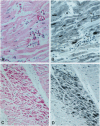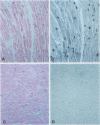Abstract
Detection and age determination of myocardial infarction (MI) is often necessary in both clinical and pathological settings. Conventional histopathological techniques are of limited utility in the demonstration of myocardial ischemic cell death (MICD) within the first 6 hours of MI. In this study, an in situ apoptosis assay was evaluated for the determination of early MICD or early MI. Sections of formalin-fixed, paraffin-embedded archival tissue blocks from 80 hearts were stained for the presence of apoptotic cells by specific labeling of nuclear DNA fragmentation. Conventional hematoxylin and eosin stain showed acute MI (group A, n = 32), equivocal evidence for MICD or early infarction (group B, n = 35), or no abnormal findings (group C, n = 13). The sensitivity and specificity of the in situ apoptosis assay for MICD were confirmed in groups A and C patients. We showed that apoptosis of myocardial cells can occur after ischemic myocardial cell injury. Virtually all documented cases of acute MI (group A) revealed a sizeable distribution of apoptotic cells visible on gross examination of glass slides. Special attention was given to patients in group B, who were at high risk for MI and for suspected but not proved cardiac death. In this group, 34/35 cases (97%) showed focal or diffuse nuclear positivity of varying degrees for apoptosis, confirming the presence of MICD. A sizeable distribution of apoptotic cells, similar to that observed in group A, was noted in 13/35 cases (37%) of group B, suggesting acute MI in these cases. The in situ assay of DNA fragmentation can detect MICD while the histological diagnosis is still inconclusive. It is estimated that with this assay one can detect MICD as early as 2 to 4 hours.
Full text
PDF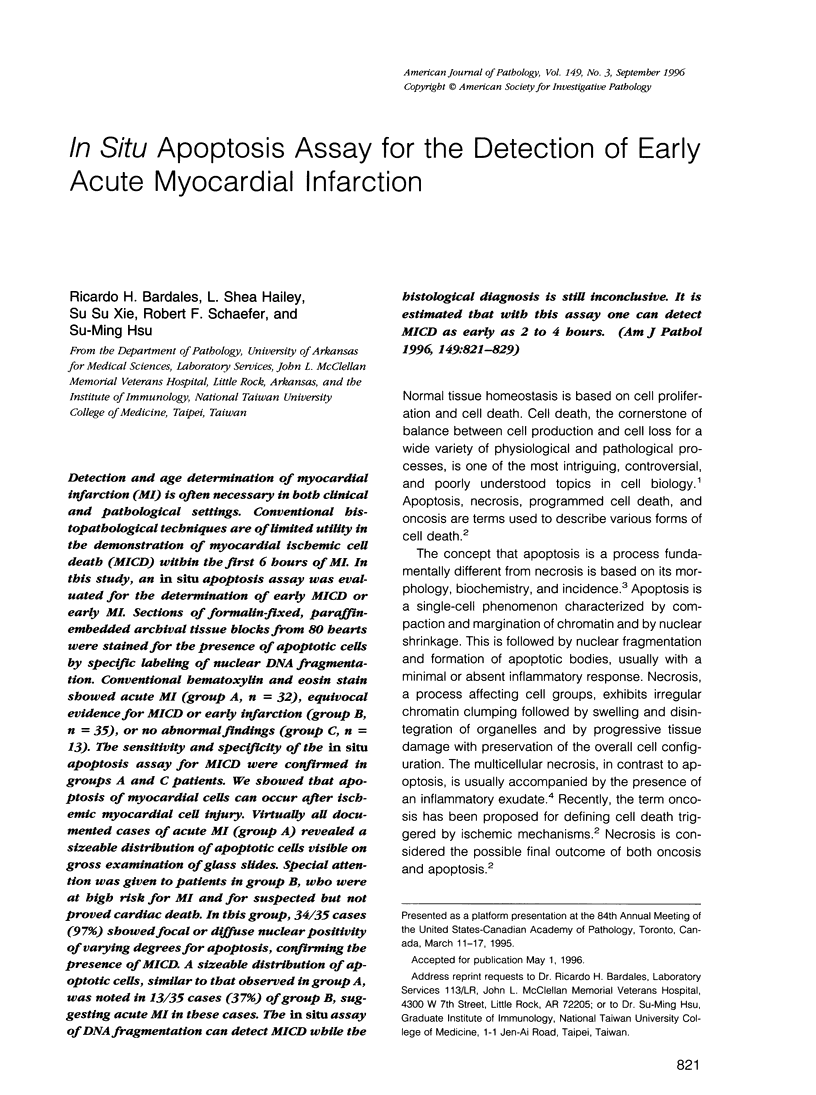
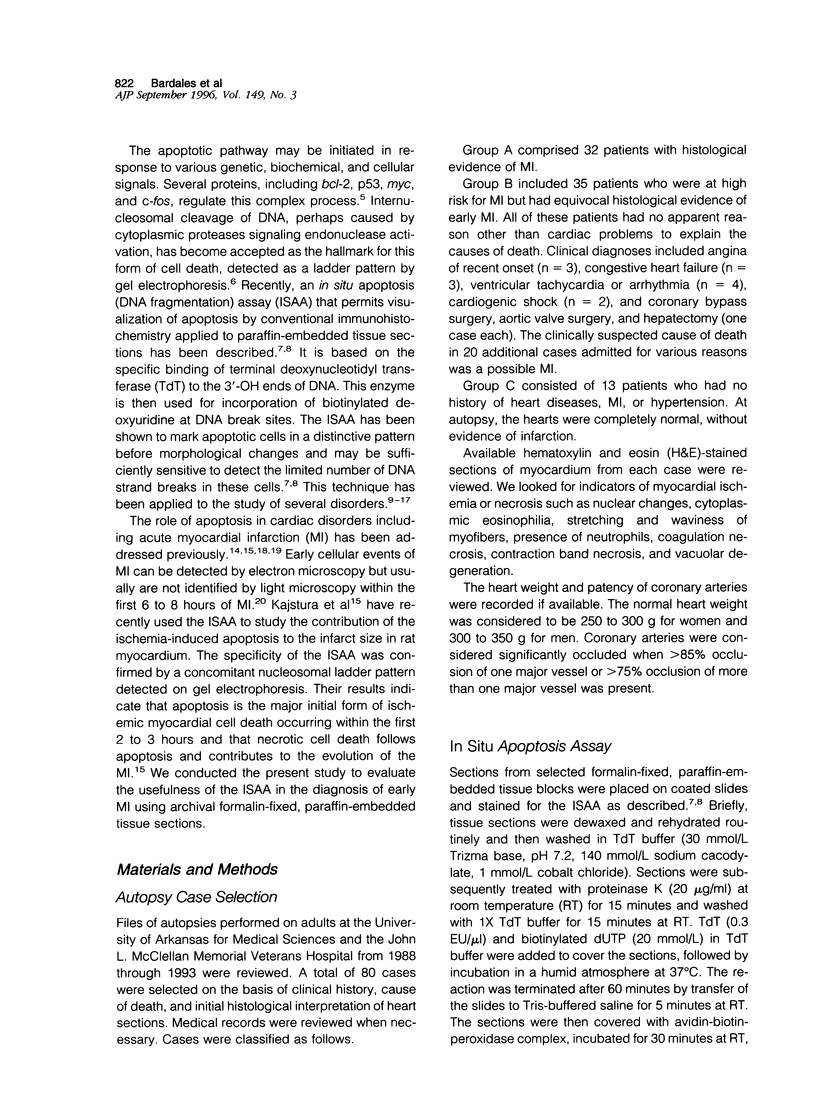
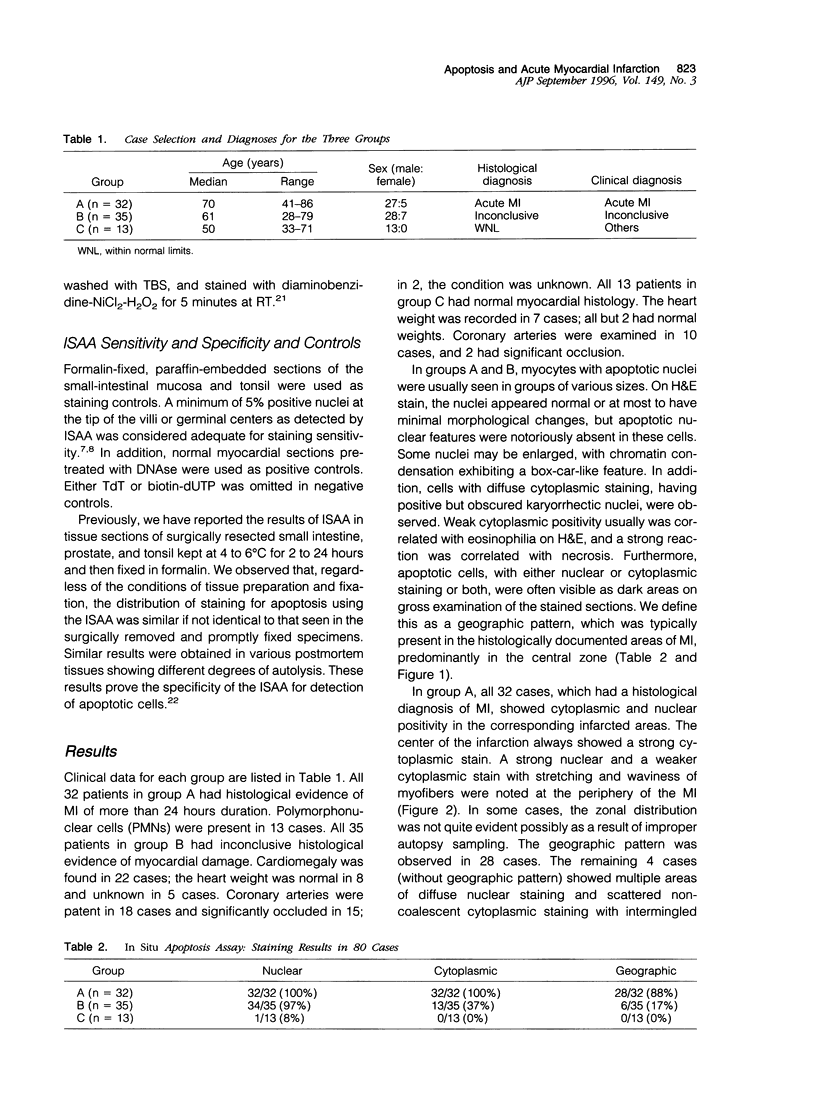
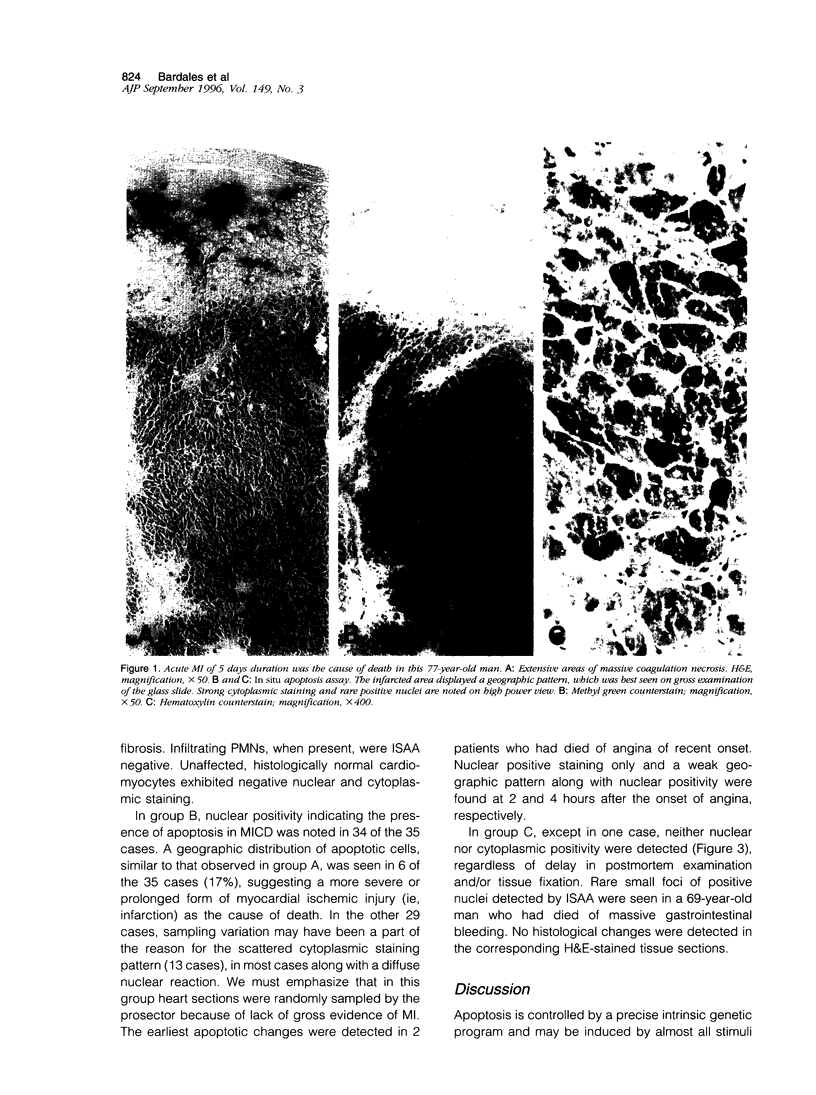
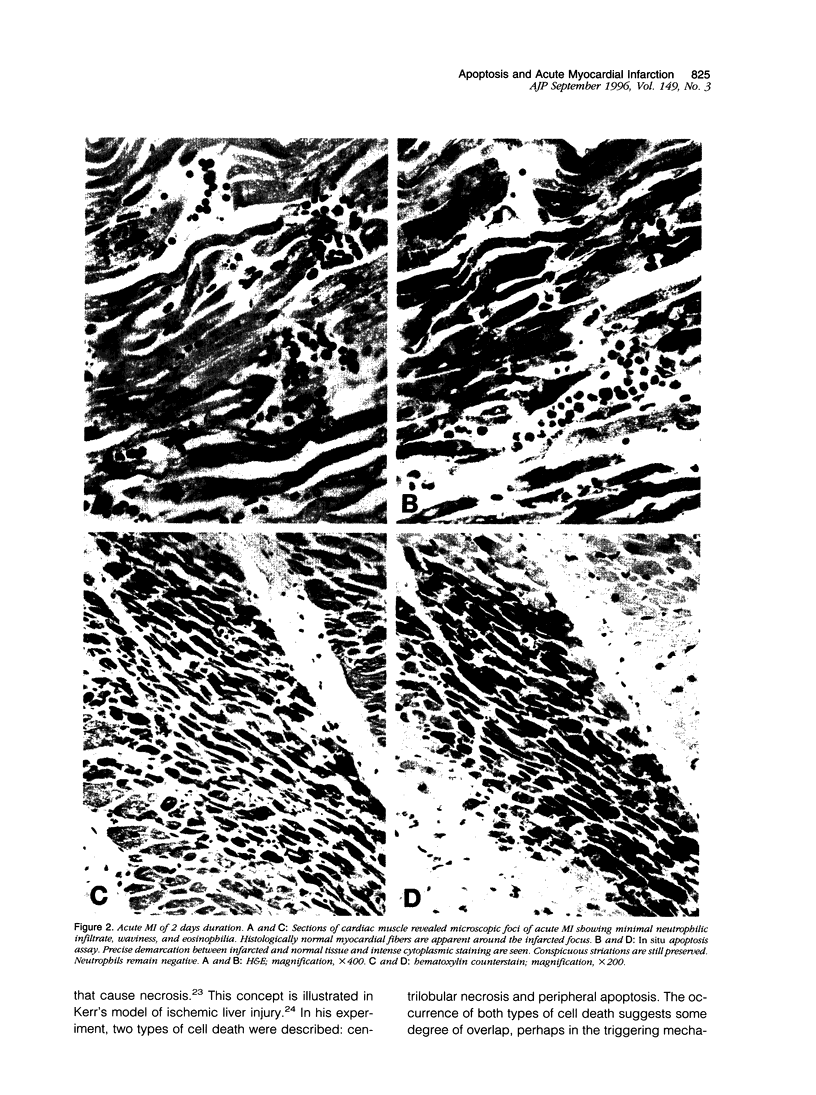
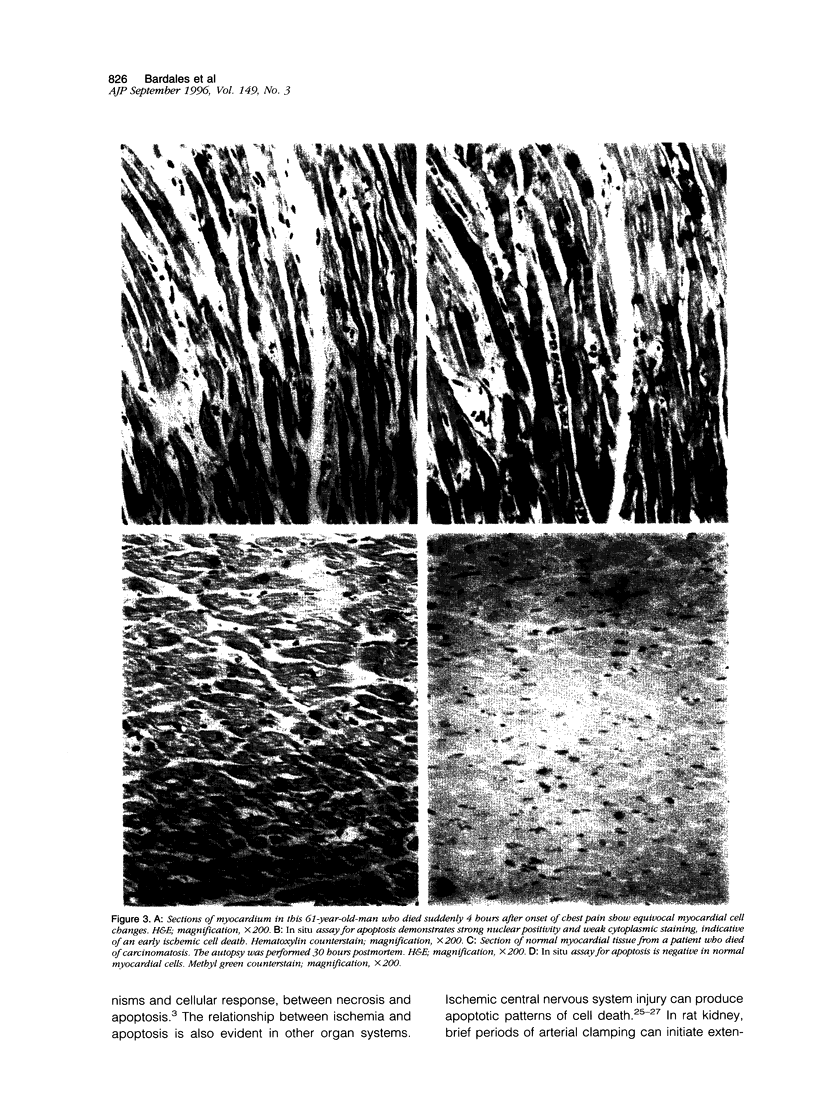
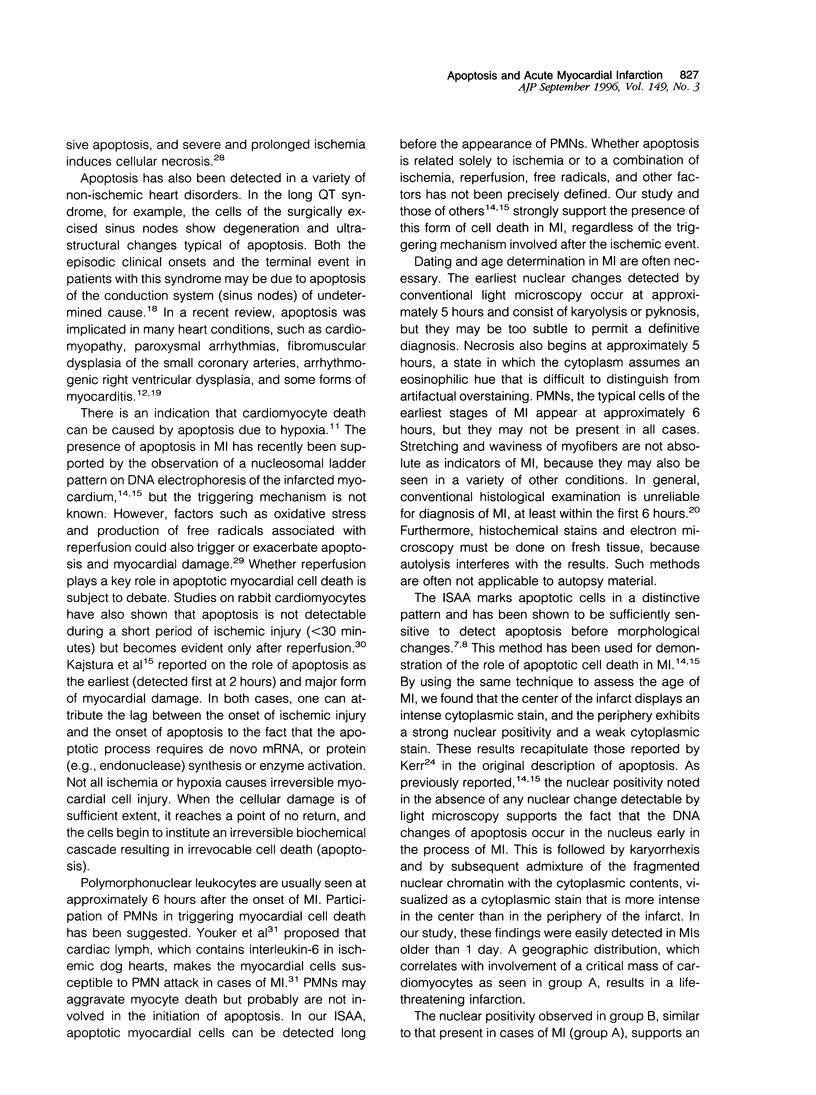
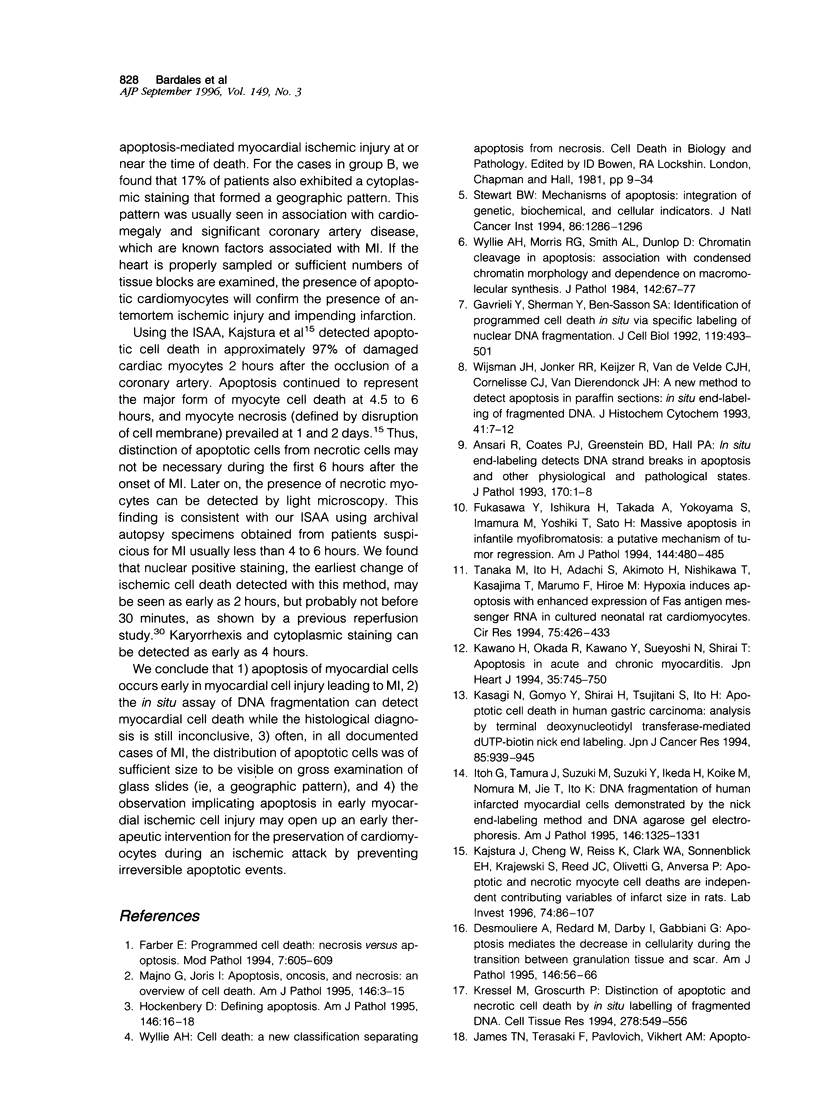
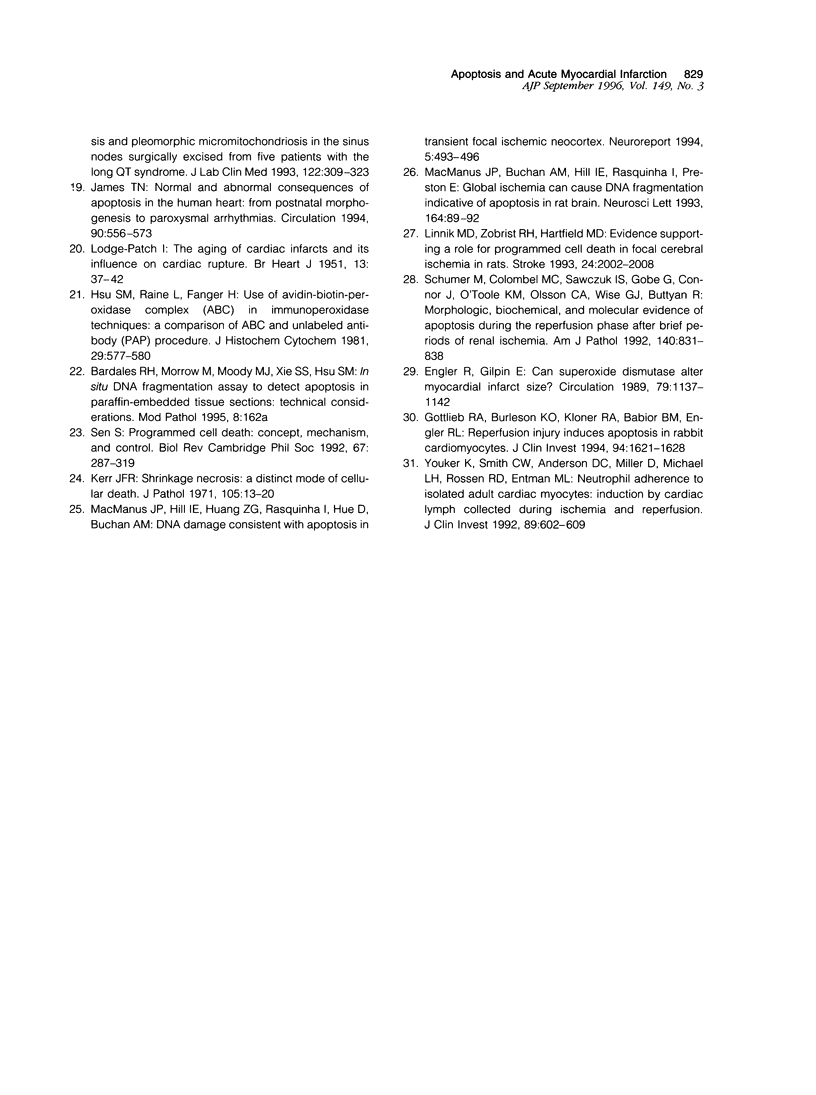
Images in this article
Selected References
These references are in PubMed. This may not be the complete list of references from this article.
- Ansari B., Coates P. J., Greenstein B. D., Hall P. A. In situ end-labelling detects DNA strand breaks in apoptosis and other physiological and pathological states. J Pathol. 1993 May;170(1):1–8. doi: 10.1002/path.1711700102. [DOI] [PubMed] [Google Scholar]
- Desmoulière A., Redard M., Darby I., Gabbiani G. Apoptosis mediates the decrease in cellularity during the transition between granulation tissue and scar. Am J Pathol. 1995 Jan;146(1):56–66. [PMC free article] [PubMed] [Google Scholar]
- Engler R., Gilpin E. Can superoxide dismutase alter myocardial infarct size? Circulation. 1989 May;79(5):1137–1142. doi: 10.1161/01.cir.79.5.1137. [DOI] [PubMed] [Google Scholar]
- Farber E. Programmed cell death: necrosis versus apoptosis. Mod Pathol. 1994 Jun;7(5):605–609. [PubMed] [Google Scholar]
- Fukasawa Y., Ishikura H., Takada A., Yokoyama S., Imamura M., Yoshiki T., Sato H. Massive apoptosis in infantile myofibromatosis. A putative mechanism of tumor regression. Am J Pathol. 1994 Mar;144(3):480–485. [PMC free article] [PubMed] [Google Scholar]
- Gavrieli Y., Sherman Y., Ben-Sasson S. A. Identification of programmed cell death in situ via specific labeling of nuclear DNA fragmentation. J Cell Biol. 1992 Nov;119(3):493–501. doi: 10.1083/jcb.119.3.493. [DOI] [PMC free article] [PubMed] [Google Scholar]
- Gottlieb R. A., Burleson K. O., Kloner R. A., Babior B. M., Engler R. L. Reperfusion injury induces apoptosis in rabbit cardiomyocytes. J Clin Invest. 1994 Oct;94(4):1621–1628. doi: 10.1172/JCI117504. [DOI] [PMC free article] [PubMed] [Google Scholar]
- Hockenbery D. Defining apoptosis. Am J Pathol. 1995 Jan;146(1):16–19. [PMC free article] [PubMed] [Google Scholar]
- Hsu S. M., Raine L., Fanger H. Use of avidin-biotin-peroxidase complex (ABC) in immunoperoxidase techniques: a comparison between ABC and unlabeled antibody (PAP) procedures. J Histochem Cytochem. 1981 Apr;29(4):577–580. doi: 10.1177/29.4.6166661. [DOI] [PubMed] [Google Scholar]
- Itoh G., Tamura J., Suzuki M., Suzuki Y., Ikeda H., Koike M., Nomura M., Jie T., Ito K. DNA fragmentation of human infarcted myocardial cells demonstrated by the nick end labeling method and DNA agarose gel electrophoresis. Am J Pathol. 1995 Jun;146(6):1325–1331. [PMC free article] [PubMed] [Google Scholar]
- James T. N. Normal and abnormal consequences of apoptosis in the human heart. From postnatal morphogenesis to paroxysmal arrhythmias. Circulation. 1994 Jul;90(1):556–573. [PubMed] [Google Scholar]
- Kajstura J., Cheng W., Reiss K., Clark W. A., Sonnenblick E. H., Krajewski S., Reed J. C., Olivetti G., Anversa P. Apoptotic and necrotic myocyte cell deaths are independent contributing variables of infarct size in rats. Lab Invest. 1996 Jan;74(1):86–107. [PubMed] [Google Scholar]
- Kasagi N., Gomyo Y., Shirai H., Tsujitani S., Ito H. Apoptotic cell death in human gastric carcinoma: analysis by terminal deoxynucleotidyl transferase-mediated dUTP-biotin nick end labeling. Jpn J Cancer Res. 1994 Sep;85(9):939–945. doi: 10.1111/j.1349-7006.1994.tb02972.x. [DOI] [PMC free article] [PubMed] [Google Scholar]
- Kawano H., Okada R., Kawano Y., Sueyoshi N., Shirai T. Apoptosis in acute and chronic myocarditis. Jpn Heart J. 1994 Nov;35(6):745–750. doi: 10.1536/ihj.35.745. [DOI] [PubMed] [Google Scholar]
- Kerr J. F. Shrinkage necrosis: a distinct mode of cellular death. J Pathol. 1971 Sep;105(1):13–20. doi: 10.1002/path.1711050103. [DOI] [PubMed] [Google Scholar]
- Kressel M., Groscurth P. Distinction of apoptotic and necrotic cell death by in situ labelling of fragmented DNA. Cell Tissue Res. 1994 Dec;278(3):549–556. doi: 10.1007/BF00331373. [DOI] [PubMed] [Google Scholar]
- LODGE-PATCH I. The ageing of cardiac infarcts, and its influence on cardiac rupture. Br Heart J. 1951 Jan;13(1):37–42. doi: 10.1136/hrt.13.1.37. [DOI] [PMC free article] [PubMed] [Google Scholar]
- Linnik M. D., Zobrist R. H., Hatfield M. D. Evidence supporting a role for programmed cell death in focal cerebral ischemia in rats. Stroke. 1993 Dec;24(12):2002–2009. doi: 10.1161/01.str.24.12.2002. [DOI] [PubMed] [Google Scholar]
- MacManus J. P., Buchan A. M., Hill I. E., Rasquinha I., Preston E. Global ischemia can cause DNA fragmentation indicative of apoptosis in rat brain. Neurosci Lett. 1993 Dec 24;164(1-2):89–92. doi: 10.1016/0304-3940(93)90864-h. [DOI] [PubMed] [Google Scholar]
- MacManus J. P., Hill I. E., Huang Z. G., Rasquinha I., Xue D., Buchan A. M. DNA damage consistent with apoptosis in transient focal ischaemic neocortex. Neuroreport. 1994 Jan 12;5(4):493–496. doi: 10.1097/00001756-199401120-00031. [DOI] [PubMed] [Google Scholar]
- Majno G., Joris I. Apoptosis, oncosis, and necrosis. An overview of cell death. Am J Pathol. 1995 Jan;146(1):3–15. [PMC free article] [PubMed] [Google Scholar]
- Schumer M., Colombel M. C., Sawczuk I. S., Gobé G., Connor J., O'Toole K. M., Olsson C. A., Wise G. J., Buttyan R. Morphologic, biochemical, and molecular evidence of apoptosis during the reperfusion phase after brief periods of renal ischemia. Am J Pathol. 1992 Apr;140(4):831–838. [PMC free article] [PubMed] [Google Scholar]
- Sen S. Programmed cell death: concept, mechanism and control. Biol Rev Camb Philos Soc. 1992 Aug;67(3):287–319. doi: 10.1111/j.1469-185x.1992.tb00727.x. [DOI] [PubMed] [Google Scholar]
- Stewart B. W. Mechanisms of apoptosis: integration of genetic, biochemical, and cellular indicators. J Natl Cancer Inst. 1994 Sep 7;86(17):1286–1296. doi: 10.1093/jnci/86.17.1286. [DOI] [PubMed] [Google Scholar]
- Tanaka M., Ito H., Adachi S., Akimoto H., Nishikawa T., Kasajima T., Marumo F., Hiroe M. Hypoxia induces apoptosis with enhanced expression of Fas antigen messenger RNA in cultured neonatal rat cardiomyocytes. Circ Res. 1994 Sep;75(3):426–433. doi: 10.1161/01.res.75.3.426. [DOI] [PubMed] [Google Scholar]
- Wijsman J. H., Jonker R. R., Keijzer R., van de Velde C. J., Cornelisse C. J., van Dierendonck J. H. A new method to detect apoptosis in paraffin sections: in situ end-labeling of fragmented DNA. J Histochem Cytochem. 1993 Jan;41(1):7–12. doi: 10.1177/41.1.7678025. [DOI] [PubMed] [Google Scholar]
- Wyllie A. H., Morris R. G., Smith A. L., Dunlop D. Chromatin cleavage in apoptosis: association with condensed chromatin morphology and dependence on macromolecular synthesis. J Pathol. 1984 Jan;142(1):67–77. doi: 10.1002/path.1711420112. [DOI] [PubMed] [Google Scholar]
- Youker K., Smith C. W., Anderson D. C., Miller D., Michael L. H., Rossen R. D., Entman M. L. Neutrophil adherence to isolated adult cardiac myocytes. Induction by cardiac lymph collected during ischemia and reperfusion. J Clin Invest. 1992 Feb;89(2):602–609. doi: 10.1172/JCI115626. [DOI] [PMC free article] [PubMed] [Google Scholar]




